Acoustic Performance of Green Composites for Chinese Traditional Percussion Drums
GAO Qiang(高 強), LIU Fanxizi(劉凡茜子), WANG Keqin(王科琴), ZHOU Mengjie(周夢婕), LANG Chenhong(郎晨宏), GUAN Fuwang(關福旺), CUI Lina(崔麗娜), ZENG Yongchun(曾泳春)*, QIU Yiping(邱夷平), *
1 Department of Technical Textiles, College of Textiles, Donghua University, Shanghai 201620, China 2 Department of Textile Engineering, College of Textiles and Apparel, Quanzhou Normal University, Quanzhou 362000, China 3 Department of Apparel and Accessory Design, College of Textiles and Apparel, Quanzhou Normal University, Quanzhou 362000, China
Abstract: Flax and jute fabrics are adopted to reinforce epoxy matrix composites in order to explore the feasibility of replacing wood in percussion instruments. The fabrics are treated with alkaline solutions to improve interfacial adhesion between fibers and epoxy. The composites are fabricated using the hand-lay and vacuum assisted resin infusion process. Acoustic dynamic moduli, acoustic radiation damping coefficients, and acoustic impedances of the composites are tested and compared with those of the wood regularly used to make the percussion instruments. It is found that the acoustic properties of the composites are within the range of those of the wood, indicating that it could be feasible to replace the wood with natural cellulose fiber reinforced composites in percussion instrument production.
Key words: natural cellulose fiber; composite; traditional percussion instrument; acoustic property; alkali treatment
Citation: GAO Q, LIU F X Z, WANG K Q,etal. Acoustic performance of green composites for Chinese traditional percussion drums[J].JournalofDonghuaUniversity(EnglishEdition), 2020, 37(2): 91-95.
Introduction
Wood is the material of choice for musical instrument production due to its unique mechanical and acoustic properties. However, the selection of wood for musical instruments is quite strict, requiring not only reasonable mechanical properties but also good acoustic performance as well as a certain degree of homogeneity of the wood structure. Therefore, only a few woods and some parts of them are suitable for making musical instruments. Furthermore, wood could be greatly affected by temperature and humidity change, it is easy to deform and grow mildew, and the resources of wood suitable for specific instruments are becoming scarce due to ever growing environmental concerns[1-2]. Therefore, it is imperative to find substitutes for wood.
Natural fibers have relatively low specific density and high specific strength and modulus which are comparable to those of glass fibers. In addition, natural cellulose fibers come from renewable sources, which are commercially available, inexpensive and biodegradable. Therefore, the raw materials for musical instruments could be gradually shifted from wood to natural fiber reinforced composites. In order to replace the traditional mahogany used in guitars, Qiu[3]prepared laminated flax/hemp fiber reinforced polylactic acid composites with different fiber volume fractions and by different fiber surface treatment methods. Flexural moduli, densities, damping characteristics and sound transmission speeds show that the alkali-treated plant fiber reinforced polylactic acid composite with a high fiber volume fraction has excellent mechanical properties, and its sound propagation speed is similar to that of mahogany. It indicates that the flax/hemp enhanced polylactic acid composite is a reasonable alternative to mahogany for guitars. Duraisamy[4]used composites made of flax fiber, bamboo fiber and epoxy resin to simulate alternative guitar fingerboards, and explored the effects of modulus, thickness and density, and temperature and humidity on the natural frequency and the damping of the composite. The results show that the flexural modulus, and thickness and density play important roles in the acoustic performance of the composite, while humidity has a greater influence on the natural frequency of the material than temperature. Hemp fiber reinforced composites are more suitable as an alternative to guitar fingerboards than bamboo fiber reinforced composites. Phillips and Lessard[5]developed a flax fiber reinforced sandwich composite for stringed instruments, which exhibited the same mechanical properties as wood. Certain manmade fiber reinforced composites have also been adopted as potential alternative materials for musical instruments. Researchers[6-7]used carbon fiber, glass fiber, and polyurethane foam to prepare sandwich composites with similar acoustic performance to the US West Plus Spruce. However, in these studies, the composites do not directly emit sound in the instrument. In many Chinese traditional percussion music performances, the body of the drum (shown in Fig. 1) is meant to be hit by sticks to make pitches in the music. Therefore, it is worth investigating the sound emission properties of fiber reinforced composites.
In this paper, flax and jute plain weave fabrics were selected as reinforcements, and epoxy was used as the matrix to prepare natural fiber fabric/epoxy composites. The acoustic properties of the composites were tested and compared with the wood commonly used in the percussion instrument, to explore the feasibility of the composite as a substitute for wood in this specific application.
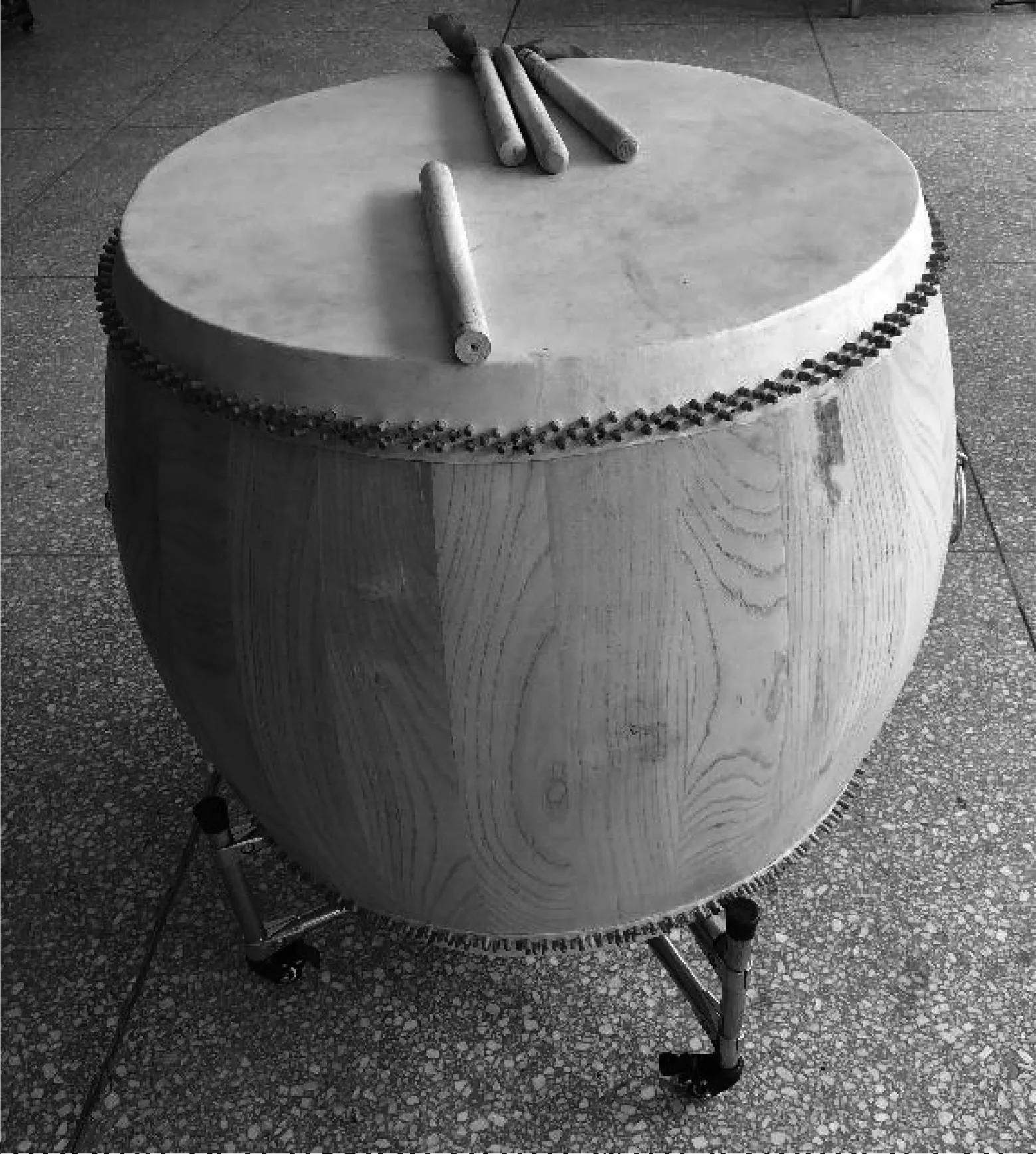
Fig. 1 A typical Chinese traditional percussion drum with a diameter of 60 cm
1 Experiments
1.1 Materials
Flax and jute fabrics were selected as the reinforcement, and epoxy resin ML5417 with a high temperature and low viscosity was used as the matrix and supplied by Wells Advanced Materials Co., Ltd., Shanghai, China. The yarn linear density in flax fabrics is 56.3 tex, and the warp and the weft counts in flax fabrics are 156 end per 10 cm and 160 pick per 10 cm, respectively. The warp and the weft yarn linear densities in jute fabrics are 259.4 tex and 253.0 tex, respectively. The warp and the weft counts in jute fabrics are 52 end per 10 cm and 49 pick per 10 cm, respectively. The wood adopted in the experiment for comparison belongs toailanthus, a typical material for the Chinese traditional percussion drum.
1.2 Alkali treatment of fabrics
Hydrophilic cellulose fibers may create a weak interface with epoxy matrices, resulting in low mechanical properties of the composite. Thus surface alkali treatments[8]were applied to the fabrics before impregnation into the resin. The fabrics were cut into 46 cm × 36 cm, subsequently infiltrated in a solution of 5% NaOH for 45 min, and then dried at 80 ℃.
1.3 Composite manufacturing
Four pieces of fabrics were stacked on a glass plate and impregnated using the vacuum assisted resin infusion molding (VARIM). The composites were cured for 24 h at room temperature around 24 ℃.
1.4 Scanning electron microscopy
The fibers were observed under a scanning electron microscope(SEM) (Hitachi TM3000, Japan). The specimens were coated with gold before being loaded onto the machine.
1.5 Principles of acoustic tests
In the transverse vibration test, the direction in which the vibration element is displaced is perpendicular to the induced stress direction. The resonant frequency of the transverse vibration is mainly affected by the size of the specimen and the method of motion control. The distance between the support point on the specimen and the edge of the specimen is about 0.224L(Lis the length of the specimen), which coincides with the node of the fundamental frequency vibration, and the fundamental resonant frequencyfris expressed as
(1)
where,wnis thenth order angular frequency, rad/s;knis determined by the vibration characteristic equation;Eis the specimen dynamic elastic modulus, GPa;Iis the bending moment of inertia;Ais the specimen cross-section area, mm2;ρis the density, kg/m3;nis also determined by the vibration characteristic equation.
Thenth order resonant frequencyfnof the wood specimen under transverse free vibration was tested. The dynamic elastic modulus and three important parameters for characterizing the vibration performance of the material were calculated by the relationship between the frequency and the dynamic elastic modulus.
(2)
where,his the specimen thickness, cm;βnis the constant related to the boundary conditions of the specimen.β1should be 4.730. Theβvalues of the second and the third orders up to thenth order of harmonics are represented byβ2,β3, ...,βnrespectively.β2= 7.853,β3= 10.996, and whenn>3,βn=(n+1/2)π.
The specific dynamic elastic modulusE/ρ, the acoustic radiation damping coefficientR, and the acoustic impedanceZwere calculated as
(3)
(4)
(5)
1.6 Acoustic test
In this study, the acoustic vibration characteristics of the composites were tested using a lateral free vibration test method with double-end free boundary conditions[9]. A diagram of the test setup is illustrated in Fig. 2. The geometric size of the composite specimens was 160 mm × 15 mm × (2.5±0.5) mm. A nylon thread was used to suspend the sample parallel to the wooden stick fixed by the metal frame, and the anchoring point of the nylon thread on the specimen was located at the node to ensure that the distance between the two nodes was 90 mm. The mass of the steel ball was about 0.11 g and the distance between the ball and the specimen was chosen based on Ref. [4].
During the experiment, one end of the specimen was struck at 18 mm from the node with the steel ball, and a sound signal was collected by a microphone located at the other end of the specimen. The microphone converted the sound signal into an electric signal, which was transmitted to a signal amplifier and a low-pass filter system. The sampling frequency was 10 kHz, the acquired data was processed by the fast Fourier transform (FFT) method to obtain a spectrum of the sound, and the natural vibration frequency of the specimen was determined according to the recorded spectrum (frequency response function).
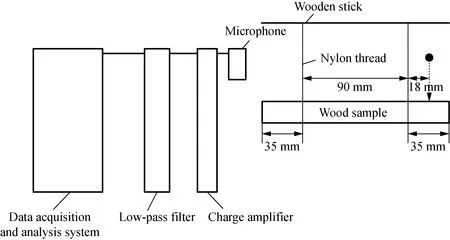
Fig. 2 Schematic diagram of the lateral free vibration test
2 Results and Discussion
2.1 Effect of alkali treatment on acoustic properties of composites
It could be seen from Table 1 that after alkali treatment, the specific dynamic elastic modulusE/ρof the flax fabric/epoxy composite decreased somewhat in both warp and weft directions because elastic moduli of the composite decreased after alkali treatment due to the increase of yarn crimp in both warp and weft directions[10-11]. The specific dynamic elastic modulus of the jute fabric/epoxy composite increased. The alkali treatment etched the surfaces of the fibers as shown in Fig. 3. It should be pointed out that the fabrics also developed increased crimp (ranging from 8° to 26°) after the alkali treatment. However, the alkali treatment may be able to increase the interfacial bonding between the jute fabric and epoxy by etching fiber surfaces (shown in Fig. 3), and therefore could compensate the negative effect of increased crimp by the alkali treatment. It may not be true for the flax fiber since it is originally a much purer and cleaner fiber.
It could be seen from Table 1 that the alkali treatment lowered the acoustic radiation damping coefficient of the flax fabric/epoxy composite, but promoted that of the jute fabric/epoxy composite. It indicates that alkali treatment could improve the acoustic vibration efficiency of jute fabric/epoxy composites.

Table 1 Average values of acoustic vibration performance parameters

(Tabel 1 continued)
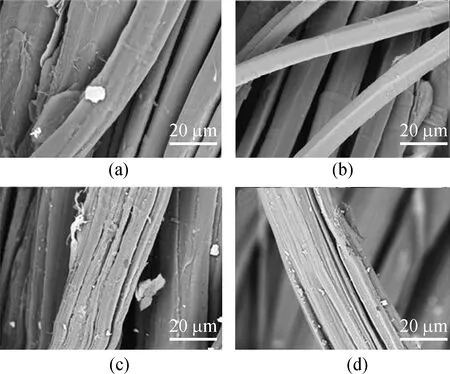
Fig. 3 SEM images: (a) flax fiber before alkali treatment; (b) jute fiber before alkali treatment; (c) flax fiber after alkali treatment; (d) jute fiber after alkali treatment
The acoustic impedance of the flax composite did not change significantly, although alkali seemed to lower the value a little due to a decrease in the specific dynamic elastic modulus. Similarly, acoustic impedance of the jute composites did not change significantly but tended to increase somewhat due to an increase in the specific dynamic elastic modulus.
2.2 Comparison of acoustic properties of composites with those of wood
It could be seen from Fig. 4 that the frequencies of the composites and the wood were both within the range of 0-5 kHz. Among them, the first to the fourth order natural frequencies of the wood were the highest, indicating that the sound was crisp and loud, and the wood specimen was tested along the grain direction. When the wood specimen was tested perpendicularly to the grain direction, the natural frequencies of the first to the fourth order had small peaks, although the frequencies had similar values, which made the sound of the horizontal stroke of the perpendicularly cut wood specimen relatively low. This indicates that the acoustic characteristics of the wood are highly anisotropic.
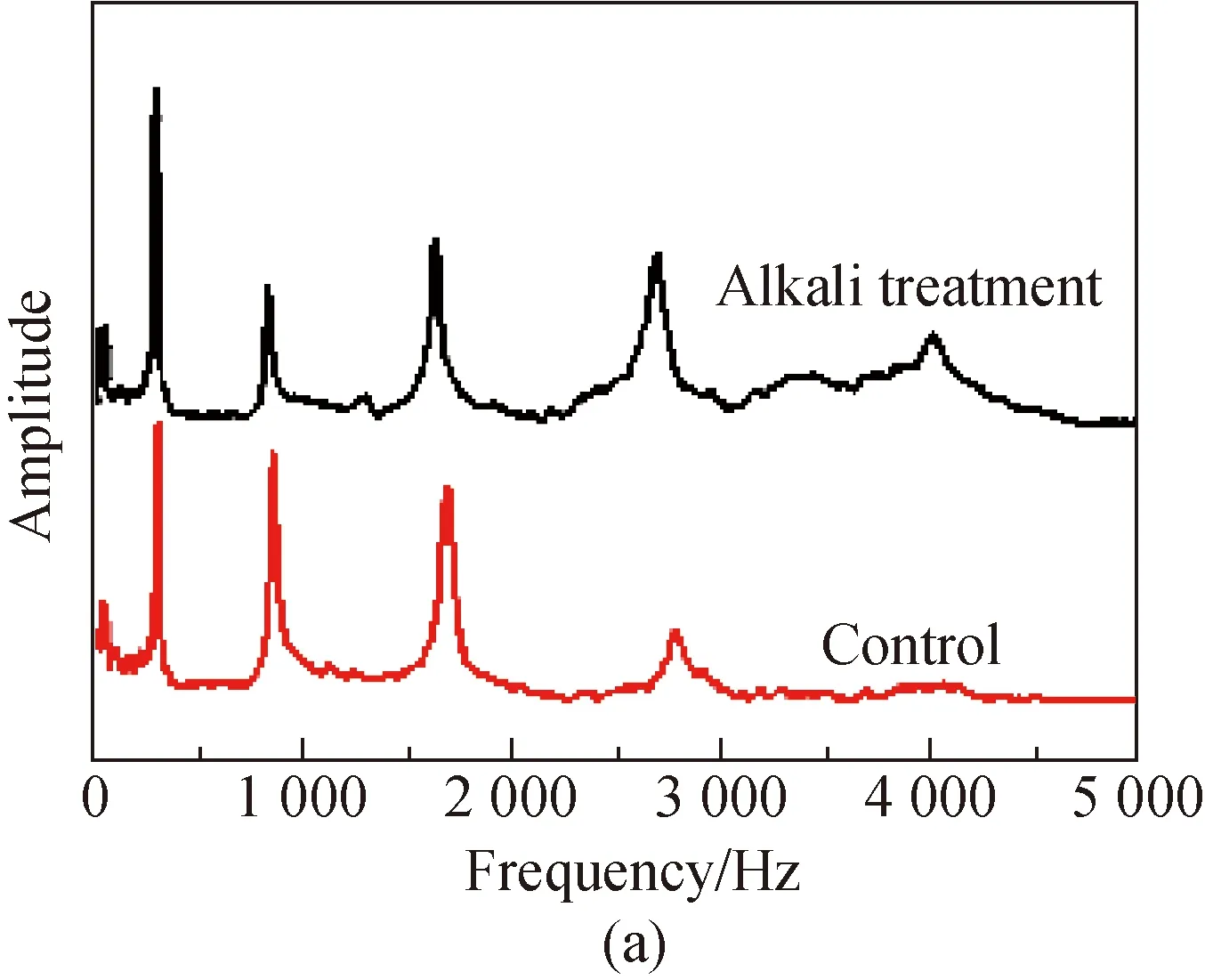
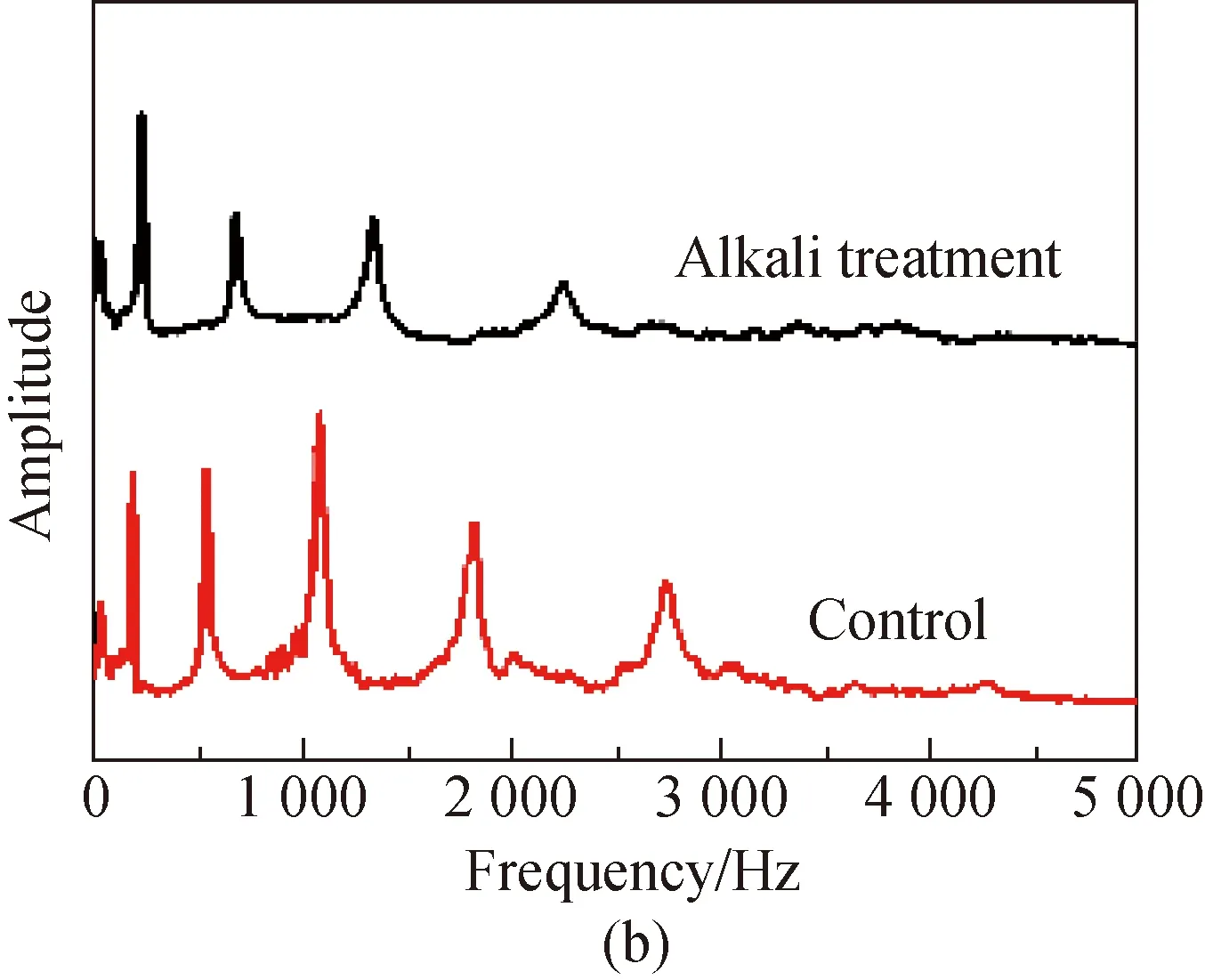

Fig. 4 Frequency response function maps of materials: (a) flax fabric/epoxy composite; (b) jute fabric/epoxy composite; (c) wood
Compared the natural frequencies of composites with those of the wood, it was found that all four natural frequencies of the composites were between the first and the fourth orders of natural frequencies of the wood, and the shapes of the spectral curves were similar, indicating that the composites could be tailored to have the same natural frequencies as the wood by changing fiber orientation and volume fractions in preferred directions of the composites. In other words, the natural cellulose fiber fabric reinforced composites should have the potential to replace the wood in the manufacture of percussion instruments.
3 Conclusions
In this paper, cellulose fiber fabric reinforced epoxy composites were prepared by the vacuum assisted resin infusion molding with flax and jute fabrics before and after alkali treatments. The acoustic properties of the composites were systematically studied and analyzed. Alkali treatment could lower the specific dynamic elastic moduli, acoustic radiation damping coefficients, and the acoustic impedances of flax fabric/epoxy composite, while the opposite was true for jute fabric/epoxy composites. The alkali treatment could increase the crimp of the yarns in the fabrics which could have a negative effect on these properties, while the improved interfacial bonding by alkali treatment could have a positive impact. The outcome of the treatment varied depending on the factor which was more dominant. The natural frequencies of the composites were in the range of those for the wood, indicating that it could be possible to use the composites to replace wood in making percussion instruments, since composite properties could be adjusted by altering the orientation and volume fractions of fibers in desirable directions.
 Journal of Donghua University(English Edition)2020年2期
Journal of Donghua University(English Edition)2020年2期
- Journal of Donghua University(English Edition)的其它文章
- Fabrication and Characterization of Polypyrrole/Polyurethane/Polyamide/Polyamide Yarn-Based Strain Sensor
- Friction and Wear Behaviors of C/C-SiC Composites under Water Lubricated Conditions
- Performance Analysis of Cushioned Sport Soles with Plantar Pressure Test
- Existence Criterion of Three-Dimensional Regular Copper-1, 3, 5-Phenyltricarboxylate (Cu-BTC) Microparticles
- Combining User-Driven Social Marketing with System-Driven Personalized Recommendation for Student Finding
- Generative Adversarial Network with Separate Learning Rule for Image Generation
